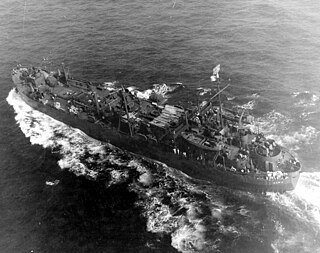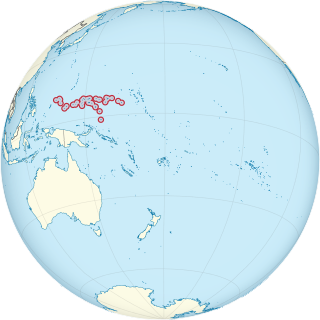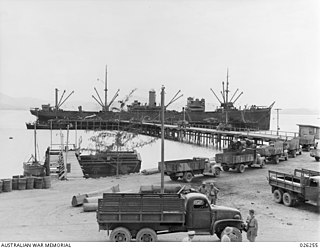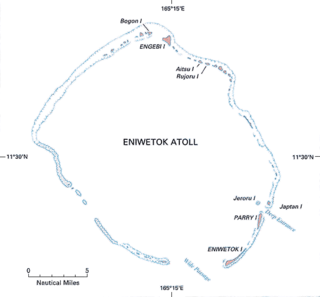



Mios Woendi island is an island in the Schouten Islands of Papua province, eastern Indonesia. It lies in Cenderawasih Bay (or Geelvink Bay) 50 kilometres (31 mi; 27 nmi) off the northwestern coast of the island nation of Papua New Guinea.




Mios Woendi island is an island in the Schouten Islands of Papua province, eastern Indonesia. It lies in Cenderawasih Bay (or Geelvink Bay) 50 kilometres (31 mi; 27 nmi) off the northwestern coast of the island nation of Papua New Guinea.
The island is in an atoll southeast of Biak, off the north coast of Papua in Western New Guinea. It is roughly a triangle in shape with the longest side 1 mile (1.6 km) in length. Padaido lagoon at Mios Woendi, provides a deep-water anchorage of nearly 5 square miles (13 km2), and the island has 2,100 feet (640 m) of navigable beach front. [1] The climate is tropical, with an annual rainfall close to 100 inches (2,540 mm). [2] The people are primarily Melanesian.
Mios Woedni was the location of a forward base,Naval Base Mios Woendi , of the United States Navy during World War II code named "Stinker". [3]
In June 1944 PT Advance Base 2 arrived along with the Seabees of PT Advance Base Construction Detachment of the 113th Naval Construction Battalion. [2] When all was done Mios Woendi would be the largest PT facility in the Pacific and named Camp Taylor for the skipper PT-193 lost. [1] To make that happen the 55th CB was sent to enlarge the camp into a 2,000 man base that would be PT Base 21. [2] There were 12 finger docks to accommodate 50 PT boats. [2] The 19th Special Construction Battalion was sent to take care of the stevedoring and had brought a 100-bed mobile dispensary to set up in addition. The dispensary would be absorbed into the 300 bed Naval Hospital 16 built by the 55th CB. The Seabees had to add more when Navy Seaplane Base 2 arrived in July. VPB-11, VPB-20, VPB-33 and VPB-34 all had aircraft there at one point. Also arriving in July was Mobile Amphibious Repair Base 2. This advance base component was designed to provide repairs and support for the operation of 18 LST's, 18 LCI's, 36 LCT's, 60 LCM's, and 240 LCVP's. Five PT drydocks plus repair shops and a torpedo depot were also constructed. [2] The last combat patrol out of Mios Woendi was mid-November 1944. [1] Ships stationed at or transitioning the base to support PT operations were the USS Hilo (AGP-2), USS Portunus (AGP-4), USS Varuna (AGP-5), USS Oyster Bay (AGP-6), USS Mobjack (AGP-7), USS Willoughby (AGP-9), USS Orestes (AGP-10) and USS Griffin (AS-13). [1] The Hilo was the Flagship of PT Task Group 70.1 and the Griffen was tasked for submarines. On short notice the Seabees built a stage for a USO show featuring Bob Hope, Frances Langford and Patty Thomas. [4]
Camp Taylor also served submarines. [3] Its torpedo depot was one reason. The other was special operations of the Combined Field Intelligence Service in support of guerrillas and coast watchers. [3] These guerrilla sub missions originated at Brisbane's,Capricorn Wharf or Mios Woendi. [5] The USS Narwhal (SS-167) one of these boats. She would have a refit at Mios Woendi and be based there for a period.
When the war ended the Dutch Navy used the facilities until 1961.
PT Squadrons at Camp Taylor at various times:

USS Hilo (AGP-2) was a converted yacht that saw service as a motor torpedo boat tender in the United States Navy during World War II. It was originally the yacht Caroline built for Eldridge R. Johnson and launched 18 July 1931. Caroline was at the time the second largest yacht and largest American built Diesel yacht. It was built with a laboratory as well as palatial quarters and was loaned and equipped by Johnson for the Johnson-Smithsonian Deep-Sea Expedition of 1933 that explored the Puerto Rico Trench. The yacht was sold in 1938 to William B. Leeds and renamed Moana replacing an earlier Leeds yacht of the same name.

USS Portunus (AGP-4) was an LST-1-class tank landing ship acquired by the U.S. Navy for use during World War II as a motor torpedo boat (MTB) tender. She was named after a Roman god of the sea, who had jurisdiction over ports and the shores.

USS Oyster Bay (AGP-6), originally and later AVP-28, was a United States Navy motor torpedo boat tender in commission from 1943 to 1946. She saw service in World War II.

The second USS Willoughby (AGP-9) was a motor torpedo boat tender that served in the United States Navy from 1944 to 1946, seeing service in the later stages of World War II. Transferred to the United States Coast Guard in 1946, she was in commission as the cutter USCGC Gresham (WAVP-387), later WHEC-387 and WAGW-387, from 1947 to 1969 and from 1970 to 1973, seeing service in the Vietnam War during her Coast Guard career.

USS Varuna (AGP-5) was a Portunus-class motor torpedo boat tender of the United States Navy during World War II.
Lombrum Naval Base, also known as HMPNGS Tarangau and formerly PNG Defence Force Base Lombrum, is a naval military base operated by the Maritime Operations Element of the Papua New Guinea Defence Force (PNGDF). It is located on Manus Island in Papua New Guinea. Lombrum is the home port of the PNGDF's Pacific-class patrol boat force.
VPB-20 was a patrol bombing squadron of the U.S. Navy. The squadron was established as Patrol Squadron 20 (VP-20) on 15 February 1944, redesignated as Patrol Bombing Squadron 20 (VPB-20) on 1 October 1944, and disestablished on 4 February 1946.

VPB-11 was a Patrol Bombing Squadron of the U.S. Navy. The squadron was established as Torpedo & Bombing Squadron 19-D14 (VT-19D14) on 7 February 1924, redesignated Torpedo & Bombing Squadron 6D14 (VT-6D14) on 1 July 1927, redesignated Patrol Squadron 6-B (VP-6B) on 1 April 1931, redesignated Patrol Squadron 6-F (VP-6F) on 17 July 1933, redesignated Patrol Squadron 6 (VP-6) on 1 October 1937, redesignated Patrol Squadron 23 (VP-23) on 1 July 1939, redesignated Patrol Squadron 11 (VP-11) on 1 August 1941, redesignated Patrol Bombing Squadron 11 (VPB-11) on 1 October 1944 and disestablished on 20 June 1945.

Naval Base Ulithi was a major United States Navy base at the Ulithi Atoll in the Caroline Islands in the western Pacific Ocean, to the north of New Guinea during World War II. The base was built to support the island-hopping Pacific war efforts of the Allied nations fighting the Empire of Japan. In terms of the number of ships at one base, Naval Base Ulithi was the largest naval base in the world in 1944 and 1945, with over 600 ships at times.

US Naval Advance Bases were built globally by the United States Navy during World War II to support and project U.S. naval operations worldwide. A few were built on Allied soil, but most were captured enemy facilities or completely new. Advance bases provided the fleet with support to keep ships tactically available with repair and supply depots of facilities, rather than return them to the continental United States. Before Japan declared war on the United States the U.S. Navy had a single fleet-sized advanced base in the Territory of Hawaii at Naval Station Pearl Harbor. During the war the U.S. Navy Seabees built over 400 advance bases categorized by size. Naval bases were either Lions or Cubs while airfields were either Oaks or Acorns. Lions and Oaks were major facilities while Cubs and Acorns were minor. PT Boats typically would get a Cub and airfields with single runways were Acorns. The larger bases could do refueling and overhaul; loading of troopship and cargo ships; and preparing amphibious assault ships. Some became major repair depots. The Seabees developed auxiliary floating drydocks were able to repair battle damage and do regular maintenance in the field saving ships trans-pacific trips for repair. A few bases also were developed to be R and R for all U.S. personnel. Most Advance Bases were built by the US Navy's Seabees in Naval Construction Battalions (CBs). At the start of the war civilian contractors were employed in construction. The Seabees in World War II built most of the airfields used by the United States Army Air Forces and United States Marine Corps, as they had the ships and cranes needed to transport the vast amount of equipment needed at the advance bases. The US Army and United States Coast Guard also operated out of many of these facilities. Seabees could build new or repair damaged runways, and with advancements in heavy bomber technology lengthen runways as needed. A few Naval Advance Bases were built for the Korean War and Vietnam War.

Naval Base Milne Bay, also called Naval Advance Base Milne Bay, was new major United States Navy sea and airbase base built on Milne Bay in Milne Bay Province in south-eastern Papua New Guinea. By spring 1943, the build up of the US Navy to support the Pacific War had caused overcrowding at the ports on the east coast of Australia. To help, Seabees departed Naval Base Brisbane on June 19, 1943 to set up a new base in Milne Bay. Naval Base Milne Bay headquarters was at Ladava Navy Base. The Royal Australian Navy already had a small base in Milne Bay: HMAS Ladava. Australians were able to defend and keep Milne Bay in the Battle of Milne Bay in 1942. Naval Base Milne Bay was built during World War II to support the many ships and aircraft fighting and patrolling in the South West Pacific theatre of war. Ladava Navy Base provided a large protective US Navy fleet anchorage at Gahora Bay next to Ladava. At Naval Base Milne Bay, Seabees built a large Naval facility.

Manus Naval Base was a number of bases built after the World War II Battle of Manus by United States Navy on the Manus Island and a smaller island just east, Los Negros Island in the Admiralty Islands chain. The major naval base construction started with the Los Negros landings on February 28, 1944. The Navy repaired and did the expansion of the airfields on the Admiralty Islands. United States Navy Seabee built or repaired the facilities on the islands. The large Manus Naval Base, also called the Admiralty Island base, supported United States Seventh Fleet, Southwest Pacific command, and part of the Pacific Fleet. The base was abandoned by the US Navy after the war.

Naval Base Brisbane was a major United States Navy base built in the early part of World War II at Brisbane, Queensland, Australia. At first, operated as a base for patrol aircraft and convoy escort aircraft to protect the last leg of the Pacific War to the Southwest Pacific. As the US Navy expanded in the island hopping campaign, Naval Base Brisbane expanded to include a submarine base, repair depot, seaplane base and other facilities. US Navy operations started on April 14, 1942, and ended after the war in 1945.

Naval Base Port Moresby was a United States Navy base built during World War II at the city of Port Moresby on Papua New Guinea. The US Navy built a communication center and advance base headquarters for the US Seventh Fleet to support the Pacific War in 1943. The base was part of the New Guinea campaign.

Naval Base Hollandia was a United States Navy base built during World War II at Humboldt Bay, near the city of Hollandia in New Guinea. The base was built by the US Navy Seabees during the Battle of Hollandia, starting on May 9, 1944. Later Naval Base Hollandia became a supply base to support the invasion of the Philippines that started on October 20, 1944. Naval Base Hollandia became an advance headquarter of the United States Seventh Fleet.

Naval Base Alexishafen was a United States Navy base built during World War II at Alexishafen, north of the city of Madang in New Guinea. The base was built by the US Navy Seabees starting June 13, 1944 as part of the New Guinea campaign of the Pacific War. The base was built at the request of the Seventh Amphibious Force of the United States Seventh Fleet to support the many boats patrolling the area. The US Navy built a boat repair depot including Auxiliary floating drydocks. The base was closed in January 28, 1945.

US Naval Base New Guinea was number of United States Navy bases on the island of New Guinea during World War II. Australia entered World War II on 3 September 1939, being a self-governing nation within the British Empire. The United States formally entered the war on 7 December 1941, following the attack on Pearl Harbor by the Empire of Japan. Following the attack on Pearl Harbor, Japan quickly took over much of the South Pacific Ocean. The United States lost key naval bases in the South Pacific, including Naval Base Manila and Naval Base Subic Bay, both lost in the 1941–42 invasion of the Philippines. Also lost were Naval Base Guam and Wake Atoll. As such, the United States Armed Forces needed new bases in the South West Pacific for staging attacks on Japan's southern empire. The United States built bases first in Australia, then in New Guinea.

Naval Base Eniwetok was a major United States Navy base located at Enewetak Atoll in the Marshall Islands, during World War II. The base was built to support the island-hopping strategy used by allied nations fighting the Empire of Japan in the Pacific War. During 1944-5 Eniwetok was one of the busiest naval bases in the world with over 488 ships.

Naval Base Kossol Roads also called Naval Base Kossol Passage was major United States Navy base at Kossol Roads in northern Palau in the western Caroline Islands in the western Pacific Ocean during World War II. Kossol Roads lagoon is surrounded by fringing coral reef. The base was built to support the island hopping Pacific war efforts of the allied nations fighting the Empire of Japan. In terms of the number of ships at one base, Naval Base Kossol Roads was one of the largest Naval Base in the world in 1944 and 1945. Naval Base Kossol Roads was unique, as it was the only large US Naval base to have no shore facilities. Kossol Roads was part of US Naval Base Carolines.

Naval Base Hawaii was a number of United States Navy bases in the Territory of Hawaii during World War II. At the start of the war, much of the Hawaiian Islands was converted from tourism to a United States Armed Forces base. With the loss of US Naval Base Philippines in Philippines campaign of 1941 and 1942, Hawaii became the US Navy's main base for the early part of the island-hopping Pacific War against Empire of Japan. Naval Station Pearl Harbor was founded in 1899 with the annexation of Hawaii.